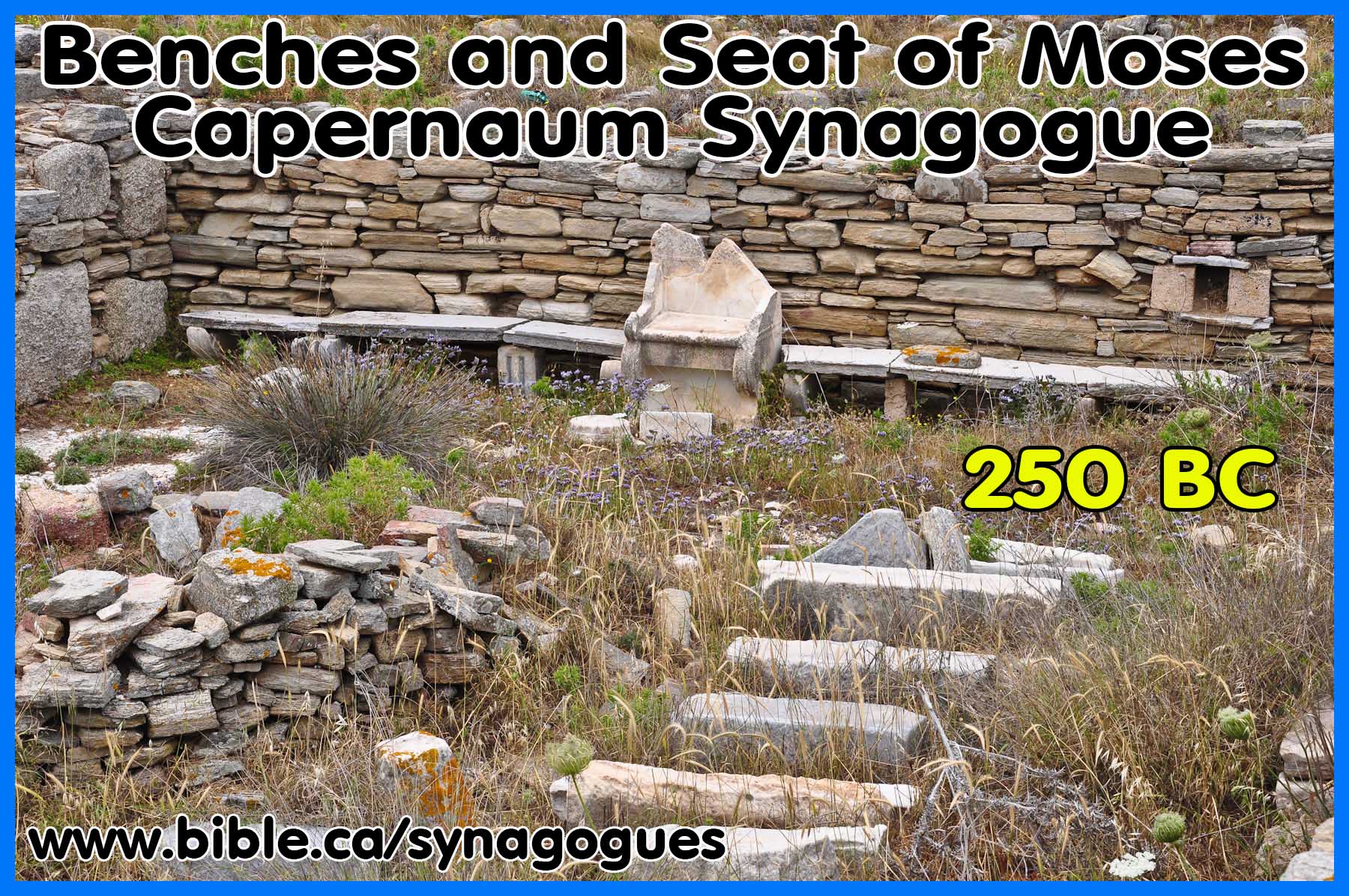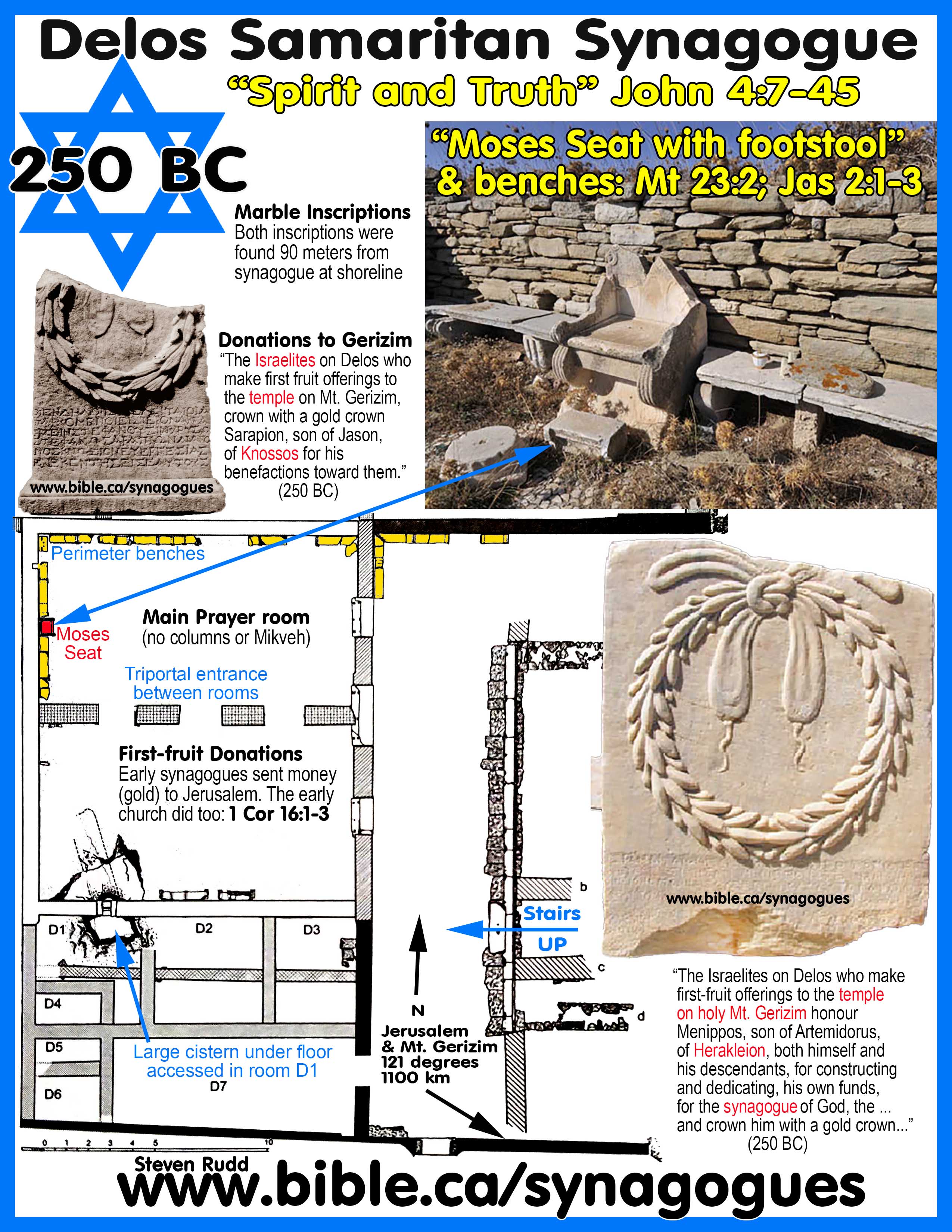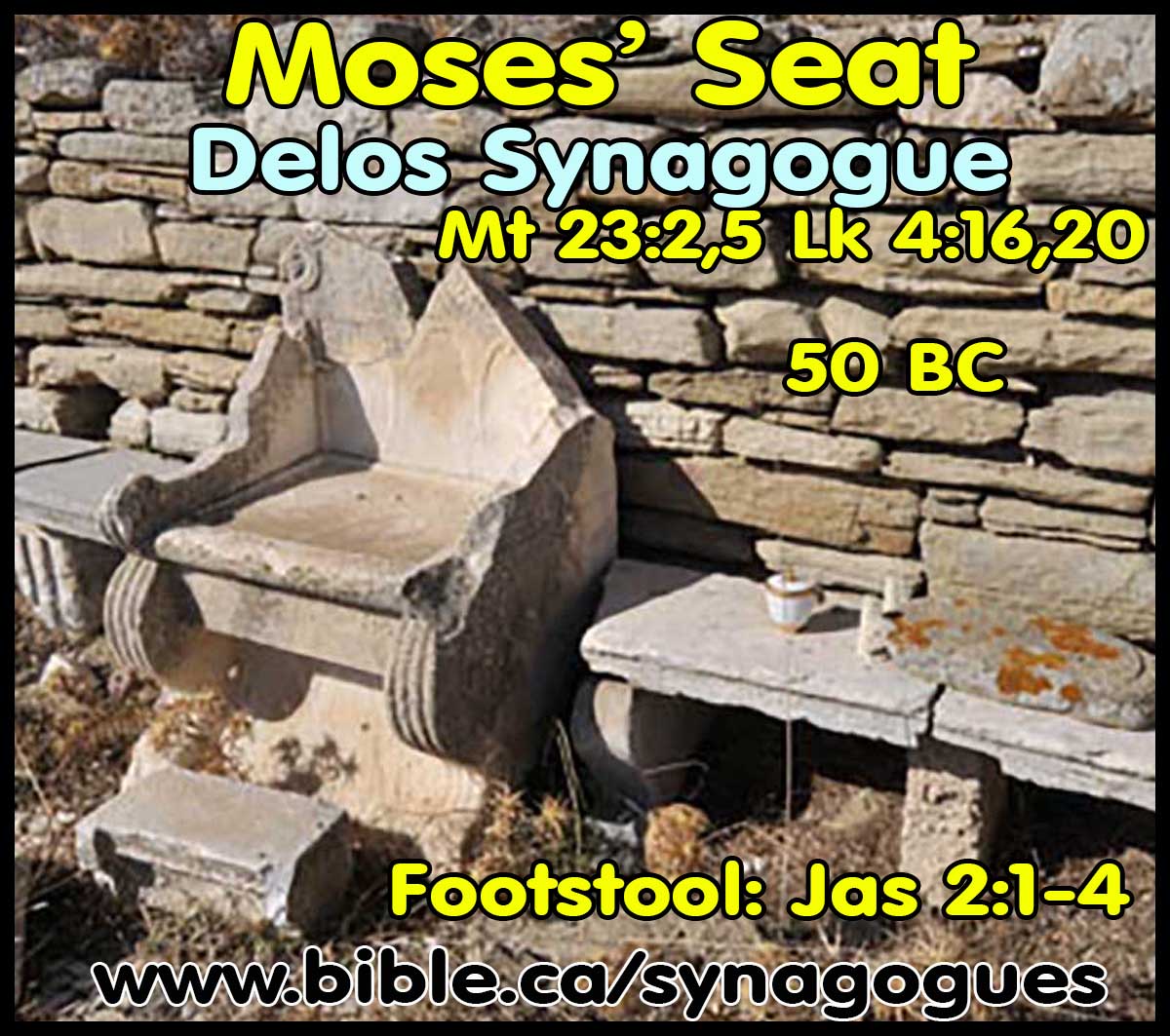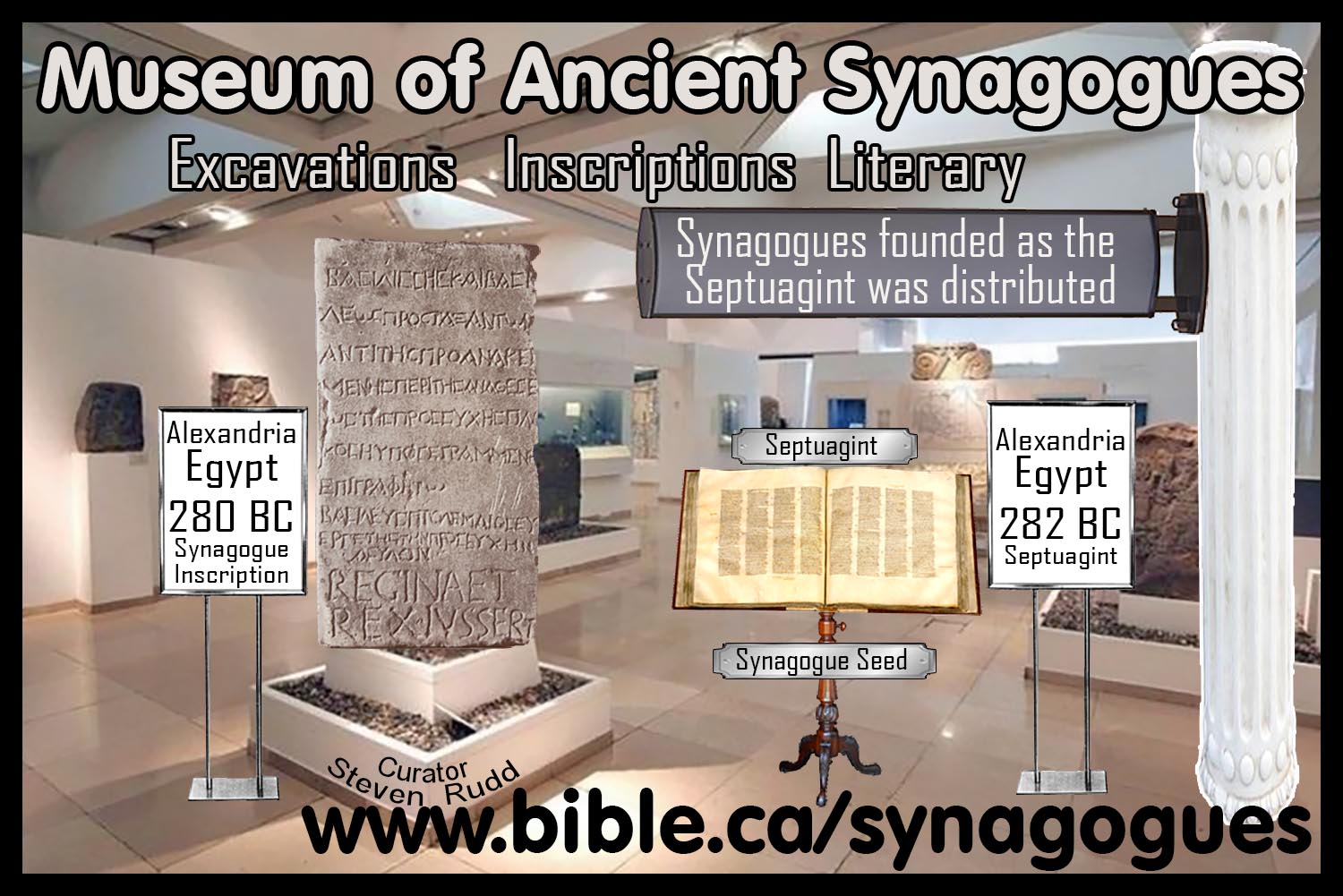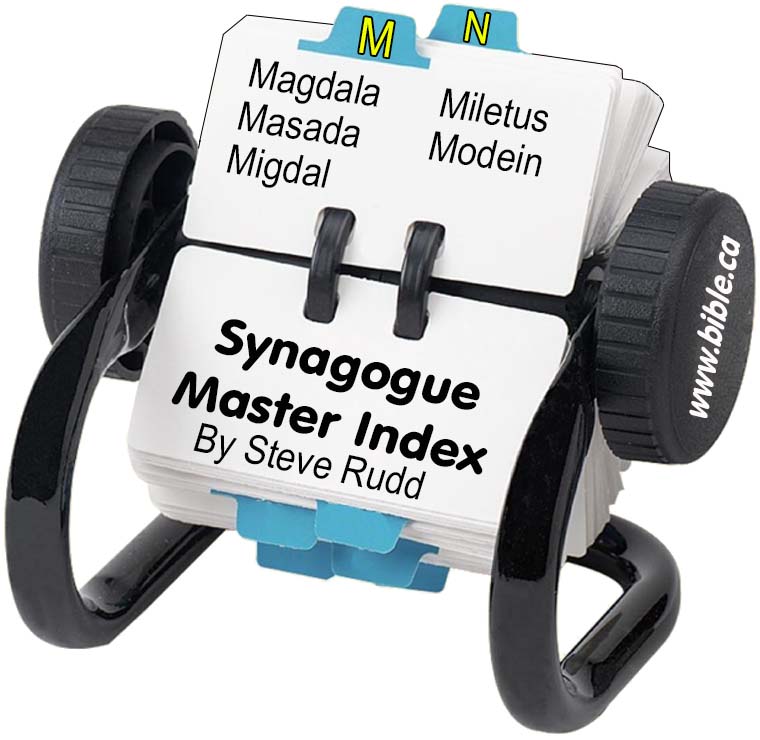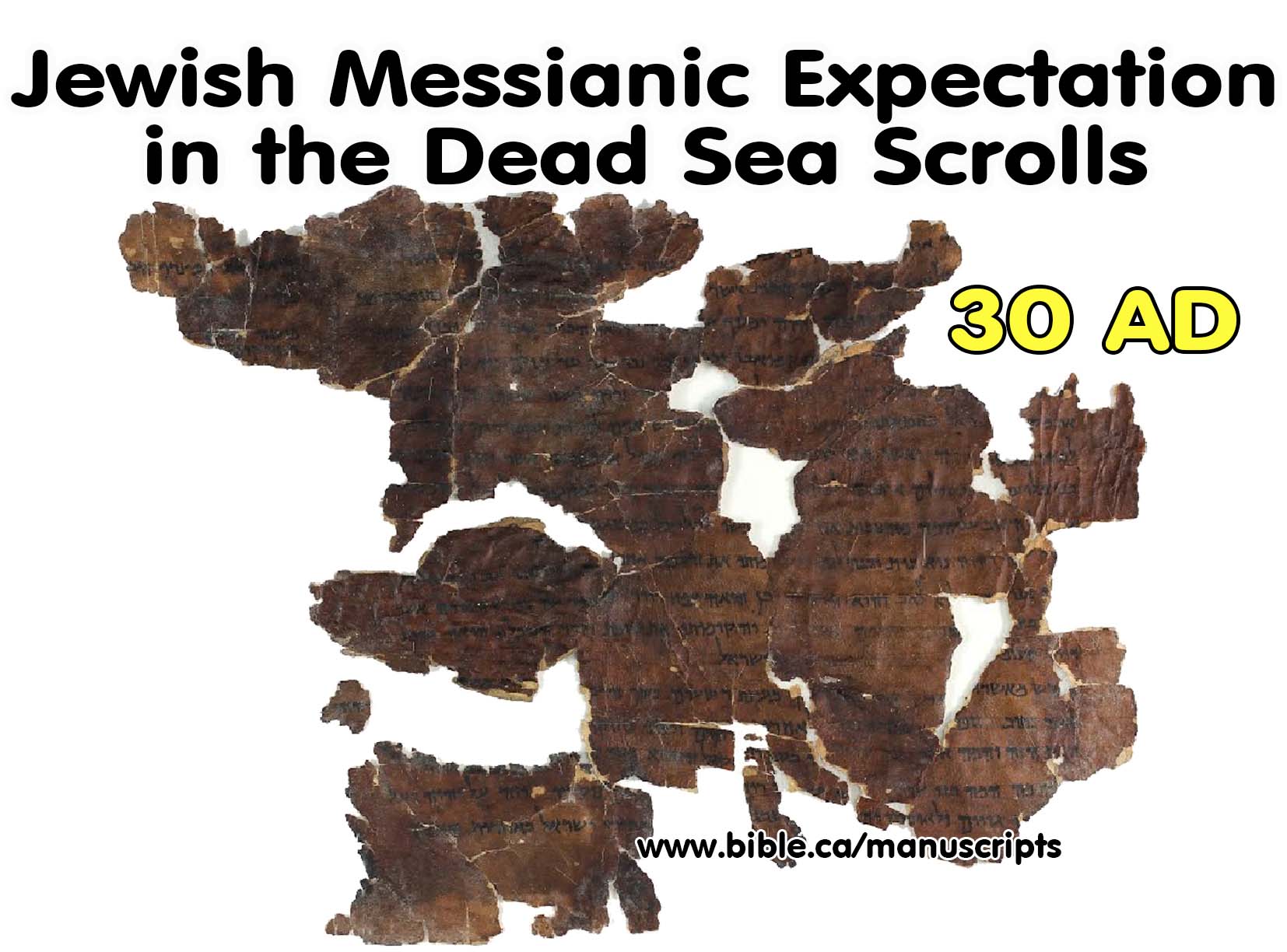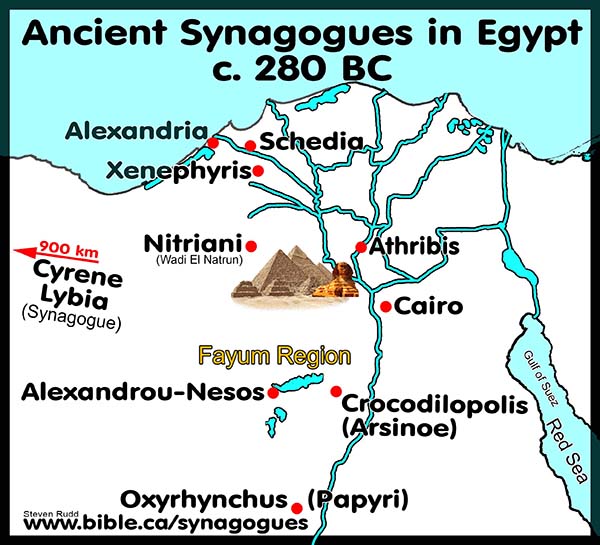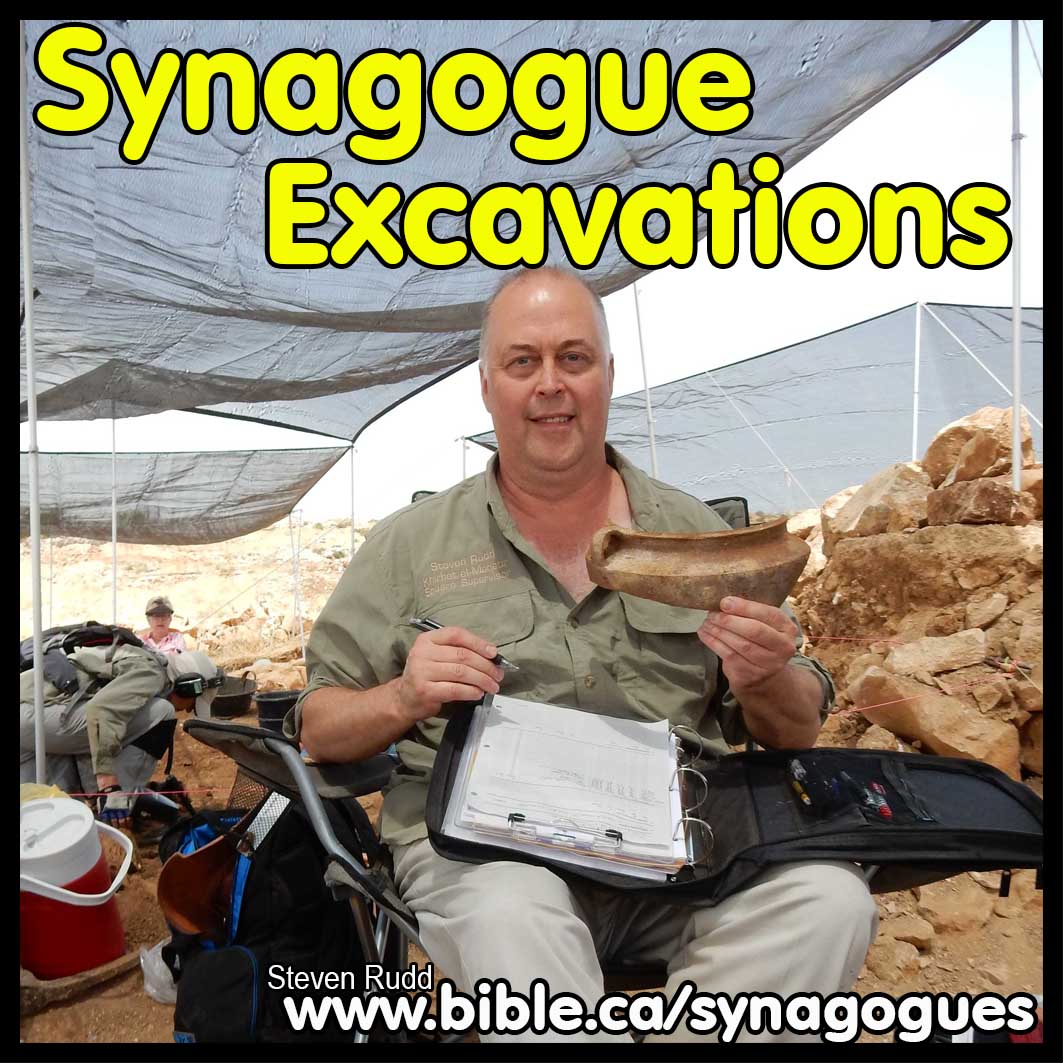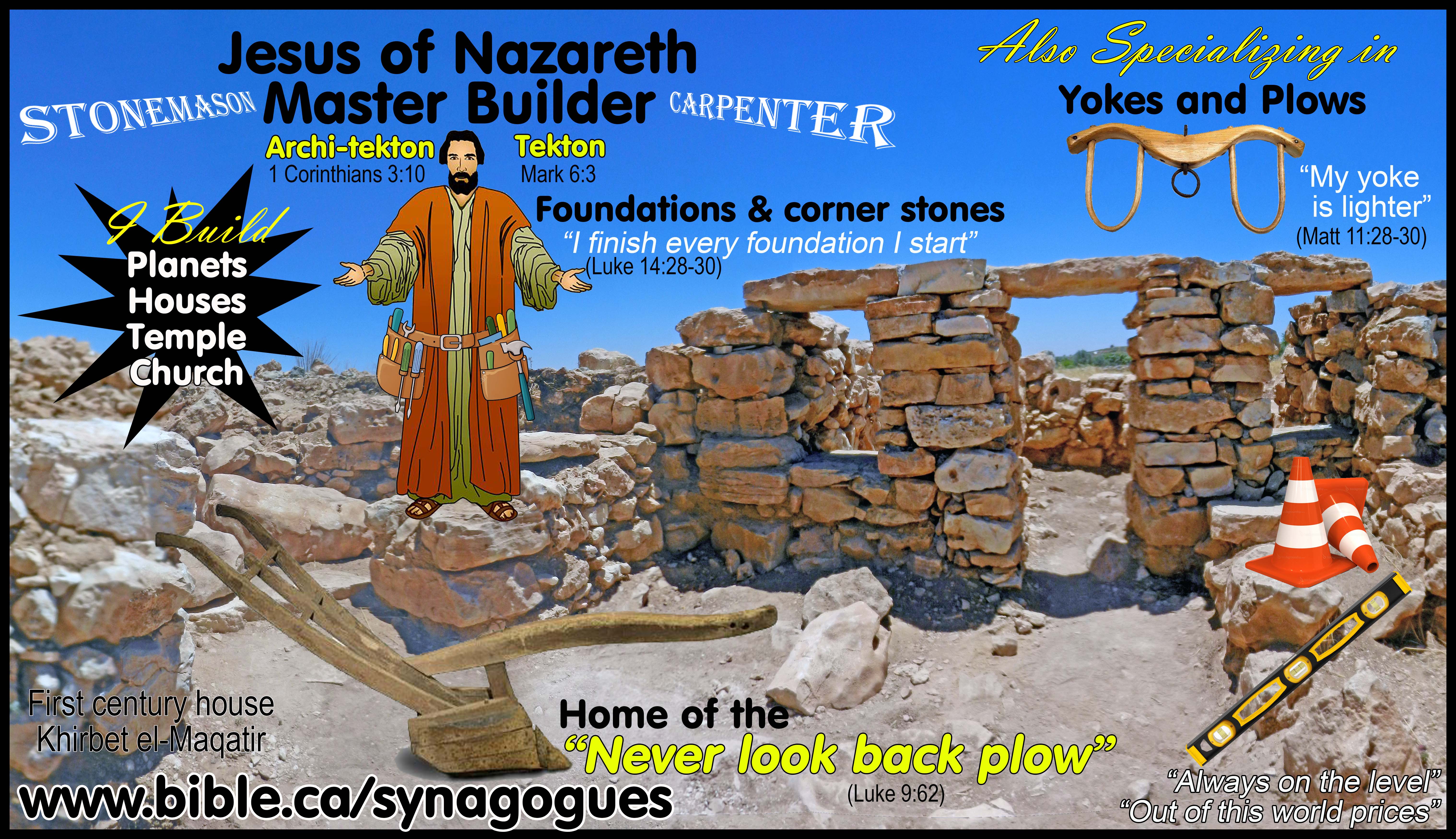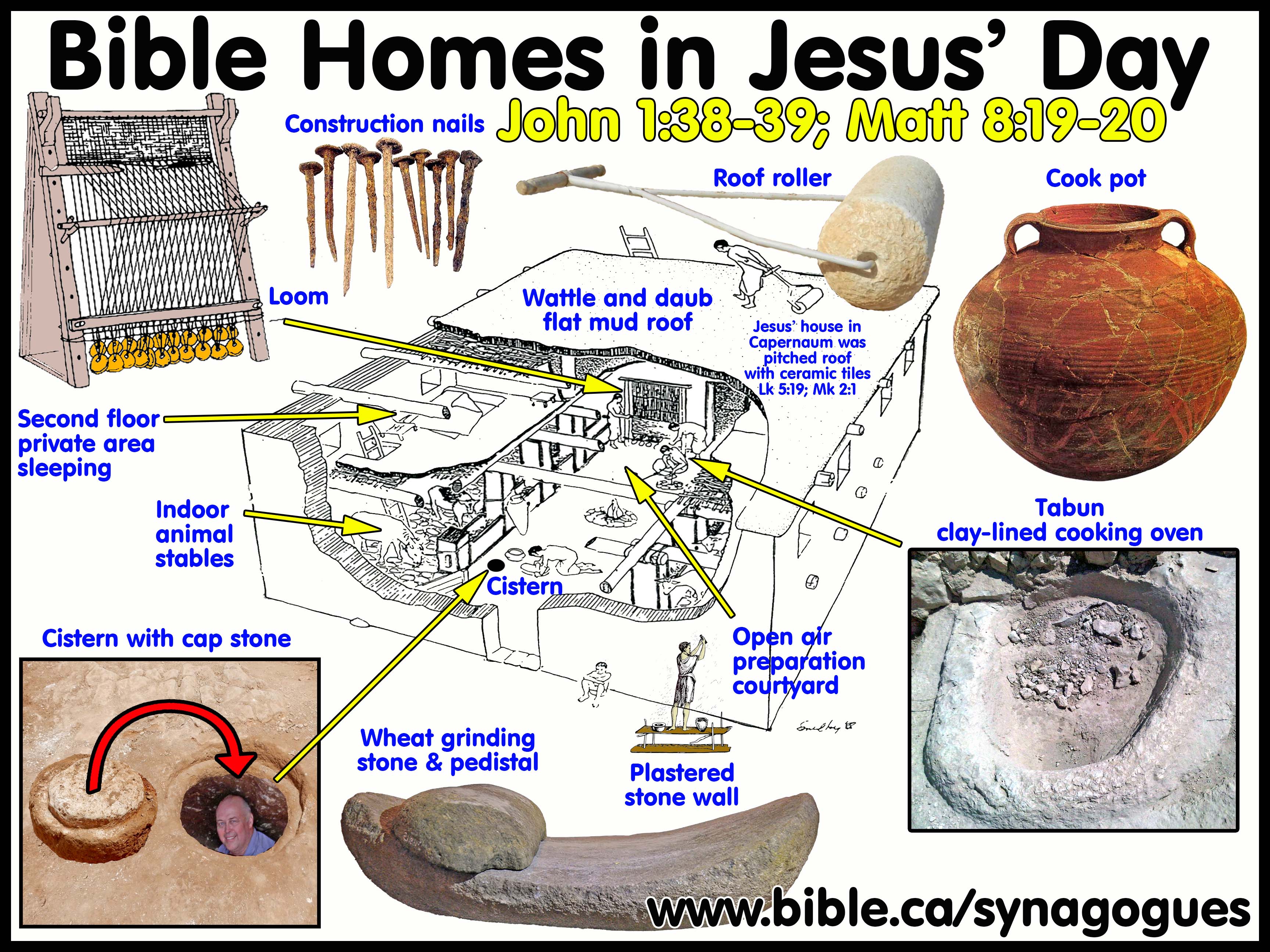First Century Synagogue Top Plans: Delos, Greece 250 BC
Archeological Excavations of Oldest Synagogues in the world
|
Delos Greece 250 BC |
Click on photos for high resolution
1.
The two inscriptions, the absence of a mikveh and a lack of columns are
evidence this is a Samaritan not Judean Synagogue.
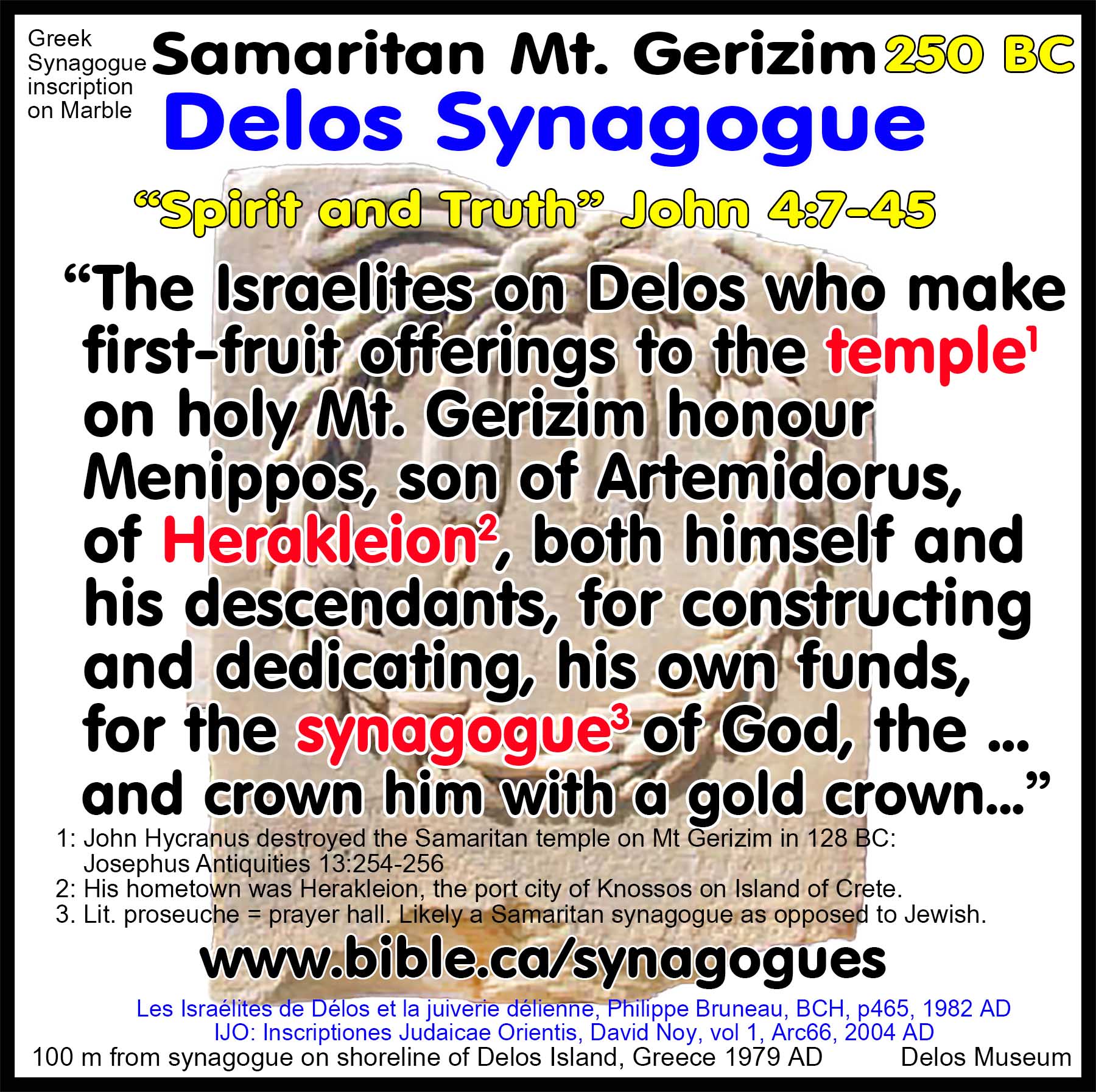
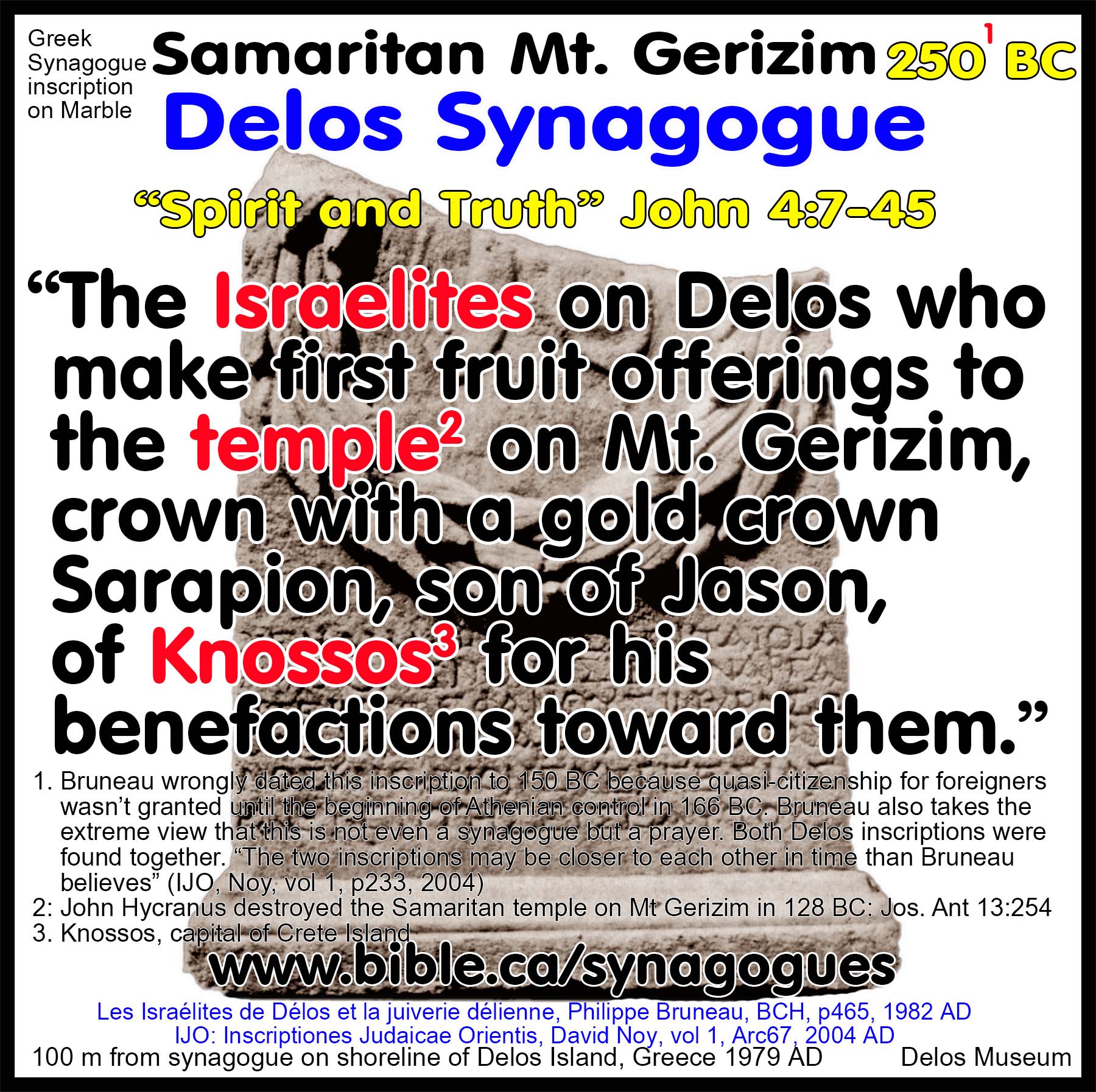
2. The lack of columns at the Samaritan synagogue proves columns in Jewish synagogues was connected with the two freestanding columns at the Jerusalem Temple of Solomon.
3. See also: The Samaritans: Full outline and their history.
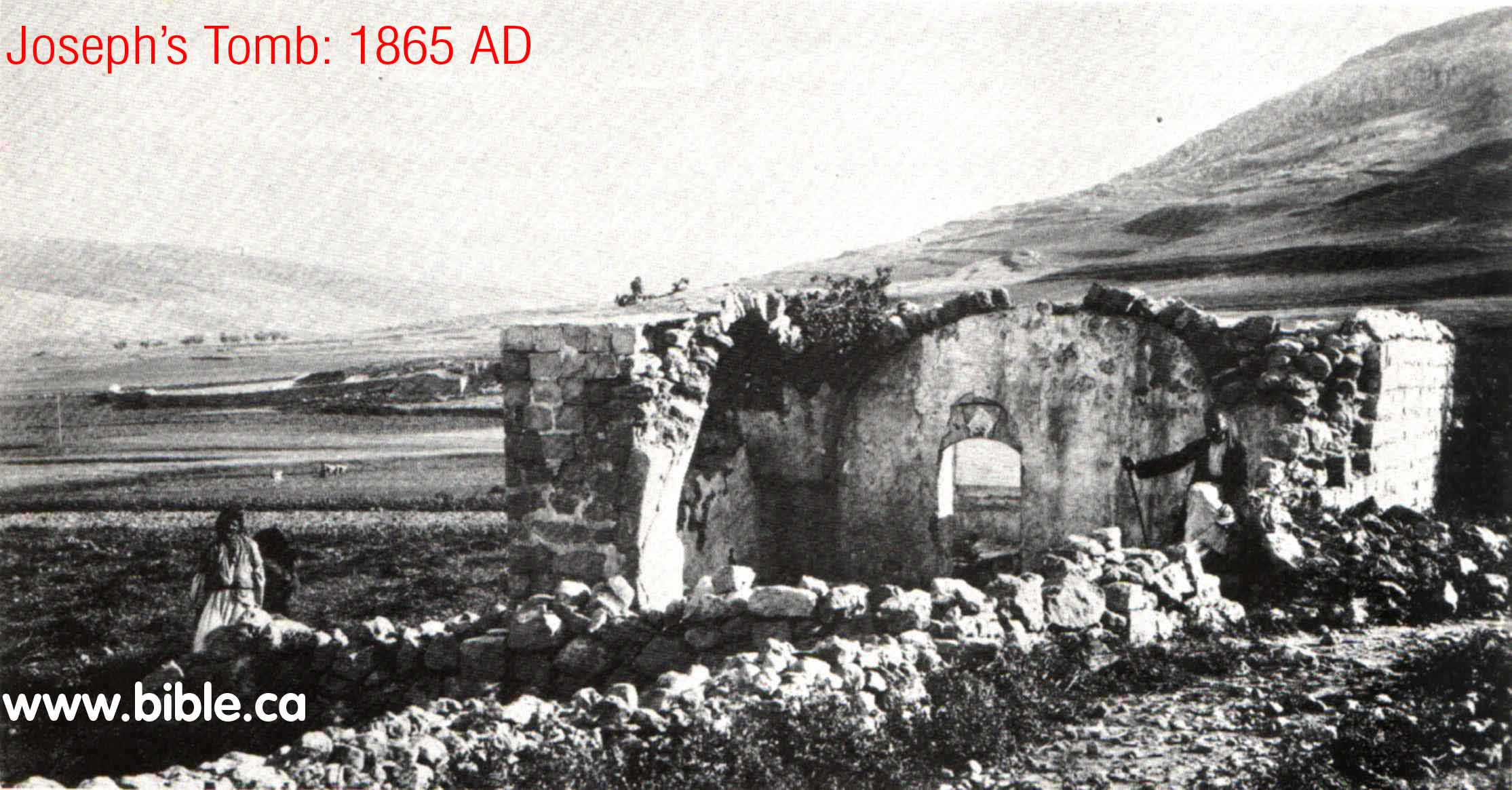
4. “The oldest synagogue in the Diaspora to be preserved, excavated, and reported is the one from the Aegean island of Delos, birthplace of Apollo. A free port in the 2d century b.c.e., Delos attracted a substantial number of Greek-speaking Samaritans who erected a synagogue there sometime in the 1st century b.c.e.” (ABD, Synagogues)
5. The synagogue MUST BE dated before 128 BC because John Hycranus destroyed the Samaritan temple on Mt Gerizim in 128 BC: Jos. Ant 13:254
A. Earliest Synagogue Occupation Date (SOD) = 250 BC
1. Excavation date: 250 BC
2. Inscriptional date: Delos 250 BC
3. Literary date: Josephus 54 BC
4. SOD computation system details: Excavation date + Inscriptional date + Literary date = SOD.
B. Synagogue Compass Orientation:
1. Orientation East or towards Jerusalem: No
2. Compass headings:
a. Compass heading towards Jerusalem: 121 Degrees
b. Distance to Jerusalem: 1100 Kilometers
3. When an archeologist begins excavating a newly discovered synagogue, the first thing he does to determine if it is a first temple, pre-70 AD installation is determine the orientation.
a. If the synagogue points east it is not pre-70 AD but built after 200 AD.
b. If the synagogue is oriented towards Jerusalem it is not pre-70 AD but built after 200 AD.
4. See Orientation: Early Synagogues did not Point to Jerusalem
C. Bible and other Literary references:
1. WOMAN AT THE WELL: "A Samaritan woman came to draw water, and Jesus said to her, “Give me a drink.” (His disciples had gone to the city to buy food.) The Samaritan woman said to him, “How is it that you, a Jew, ask a drink of me, a woman of Samaria?” (Jews do not share things in common with Samaritans.) Jesus answered her, “If you knew the gift of God, and who it is that is saying to you, ‘Give me a drink,’ you would have asked him, and he would have given you living water.” The woman said to him, “Sir, you have no bucket, and the well is deep. Where do you get that living water? Are you greater than our ancestor Jacob, who gave us the well, and with his sons and his flocks drank from it?” Jesus said to her, “Everyone who drinks of this water will be thirsty again, but those who drink of the water that I will give them will never be thirsty. The water that I will give will become in them a spring of water gushing up to eternal life.” The woman said to him, “Sir, give me this water, so that I may never be thirsty or have to keep coming here to draw water.” Jesus said to her, “Go, call your husband, and come back.” The woman answered him, “I have no husband.” Jesus said to her, “You are right in saying, ‘I have no husband’; for you have had five husbands, and the one you have now is not your husband. What you have said is true!” The woman said to him, “Sir, I see that you are a prophet. Our ancestors worshiped on this mountain, but you say that the place where people must worship is in Jerusalem.” Jesus said to her, “Woman, believe me, the hour is coming when you will worship the Father neither on this mountain nor in Jerusalem. You worship what you do not know; we worship what we know, for salvation is from the Jews. But the hour is coming, and is now here, when the true worshipers will worship the Father in spirit and truth, for the Father seeks such as these to worship him. God is spirit, and those who worship him must worship in spirit and truth.” The woman said to him, “I know that Messiah is coming” (who is called Christ). “When he comes, he will proclaim all things to us.” Jesus said to her, “I am he, the one who is speaking to you.” Just then his disciples came. They were astonished that he was speaking with a woman, but no one said, “What do you want?” or, “Why are you speaking with her?” Then the woman left her water jar and went back to the city. She said to the people, “Come and see a man who told me everything I have ever done! He cannot be the Messiah, can he?” They left the city and were on their way to him. Meanwhile the disciples were urging him, “Rabbi, eat something.” But he said to them, “I have food to eat that you do not know about.” So the disciples said to one another, “Surely no one has brought him something to eat?” Jesus said to them, “My food is to do the will of him who sent me and to complete his work. Do you not say, ‘Four months more, then comes the harvest’? But I tell you, look around you, and see how the fields are ripe for harvesting. The reaper is already receiving wages and is gathering fruit for eternal life, so that sower and reaper may rejoice together. For here the saying holds true, ‘One sows and another reaps.’ I sent you to reap that for which you did not labor. Others have labored, and you have entered into their labor.” Many Samaritans from that city believed in him because of the woman’s testimony, “He told me everything I have ever done.” So when the Samaritans came to him, they asked him to stay with them; and he stayed there two days. And many more believed because of his word. They said to the woman, “It is no longer because of what you said that we believe, for we have heard for ourselves, and we know that this is truly the Savior of the world.” When the two days were over, he went from that place to Galilee (for Jesus himself had testified that a prophet has no honor in the prophet’s own country). When he came to Galilee, the Galileans welcomed him, since they had seen all that he had done in Jerusalem at the festival; for they too had gone to the festival." (John 4:7–45)
2. GOOD SAMARITAN: "Jesus replied and said, “A man was going down from Jerusalem to Jericho, and fell among robbers, and they stripped him and beat him, and went away leaving him half dead. “And by chance a priest was going down on that road, and when he saw him, he passed by on the other side. “Likewise a Levite also, when he came to the place and saw him, passed by on the other side. “But a Samaritan, who was on a journey, came upon him; and when he saw him, he felt compassion, and came to him and bandaged up his wounds, pouring oil and wine on them; and he put him on his own beast, and brought him to an inn and took care of him. “On the next day he took out two denarii and gave them to the innkeeper and said, ‘Take care of him; and whatever more you spend, when I return I will repay you.’ “Which of these three do you think proved to be a neighbor to the man who fell into the robbers’ hands?” And he said, “The one who showed mercy toward him.” Then Jesus said to him, “Go and do the same.”" (Luke 10:30–37)
3. 54 BC: “Julius Caius, praetor [consul] of Rome, to the magistrates, senate, and people of the Parians, sendeth greeting. The Jews of Delos, and some other Jews that sojourn there in the presence of your ambassadors, signified to us, that, by a decree of yours, you forbid them to make use of the customs of their forefathers, and their way of sacred worship. (214) Now it does not please me that such decrees should be made against our friends and confederates, whereby they are forbidden to live according to their own customs, or to bring in contributions for common suppers and holy festivals, while they are not forbidden so to do even at Rome itself; (215) for even Caius Caesar, our imperator and consul, in that decree wherein he forbade the Bacchanal rioters to meet in the city, did yet permit these Jews and these only, both to bring in their contributions, and to make their common suppers. (216) Accordingly, when I forbid other Bacchanal rioters, I permit these Jews to gather themselves together, according to the customs and laws of their forefathers, and to persist therein. It will be therefore good for you, that if you have made any decree against these our friends and confederates, to abrogate the same, by reason of their virtue, and kind disposition towards us.” (Josephus, Antiquities 14.213–216, 54 BC)
4. 128 BC: “(254) But when Hyrcanus heard of the death of Antiochus he presently made an expedition against the cities of Syria, hoping to find them destitute of fighting men, and of such as were able to defend them. (255) However, it was not till the sixth month that he took Medaba, and that not without the greatest distress of his army. After this he took Samega, and the neighboring places; and, besides these, Shechem and Gerizzim (Mt. Gerizim), and the nation of the Cutheans, (256) who dwelt at the temple which resembled that temple which was at Jerusalem, and which Alexander permitted Sanballat, the general of his army, to build for the sake of Manasseh, who was son-in-law to Jadua the high priest, as we have formerly related; which temple was now deserted two hundred years after it was built.” (Josephus Antiquities 13.254–256, 128 BC)
D. Occupation history:
1. The Delos synagogue began shortly after the Septuagint was translated and sent to all the diaspora Greek speaking Jews around the world who were elated to have the Torah in their own language.
2. “The synagogue of Delos The earliest known synagogue building, from the Greek island of Delos, dates from the first century B.C.E. to the end of the second century C.E. (Drawing 1). The building is surely a private, peristyle courtyard house built as early as the second century B.C.E. but renovated for Jewish community use about the beginning of the first century B.C.E. The house had been situated near the shore in a domestic neighborhood during the course of the second century B.C.E. The building continued in use as a synagogue at least until some time during the second century C.E. After the renovations, three entrances led into the assembly worship area, sometimes understood to be the synagogue proper (Room A) from Room B to the south. Another entry opened from the east from the courtyard and its porch. This main hall (room A) is a simple rectangle about 14.4 × 16.9 m., quite large by ancient standards but half as large as the original room formed of Rooms A and B. The excavators found marble benches both on the northern wall and on the western wall of the Main Hall. This is a provision for a seated congregation. In the published plans, there is also a evidence that marble benches were found on the south wall of Room B. These benches are about 45 cm. wide. In the middle of the extant bench on the west is a fine marble “throne,” designated a “Seat of Moses” in some publications, though probably erroneously. This throne resembles most strongly the throne of the priest of Dionysos in the theater at Athens. It doubtless was for the president or presiding officer of the synagogue at some of the meetings held there. He may have been flanked by other dignitaries on the western marble bench. In any case it is clear that the architecture followed the social structure of the gathering. The rooms to the south of the main room contained no identifiable furniture. A cistern beneath the floor of the middle room contained lamps with many pagan motifs on the depressed discus of each. These attest to the Roman context in which the synagogue operated. The identification of this building as a synagogue rests upon inscriptional evidence. Many inscriptions “in accordance with a vow” (ex voto) were found on marble columns and bases in the building. These contain references to “the highest God” (theos hypsistos), taken to refer to the God of Judaism. One of the inscriptions on an inscribed base also contained the Greek word proseuchð, again a common word for synagogues in the diaspora. The inscription reads: AGATHOCLES AND LYSIMACHUS (GAVE THIS) TO THE HOUSE OF PRAYER.” (The encyclopedia of Judaism, Neusner, Volume 3, Page 1375, 2000 AD)
E. Excavation details:
1. “Discovered in the early part of the twentieth century, the building at Delos, an Aegean island lying to the south and east of the Greek mainland, has been a subject of debate for decades. Only since the 1970’s has a consensus emerged that the building was a synagogue, the earliest known to date and the only building complex securely identified as such from the pre-70 Diaspora. It is unclear precisely when the local Jewish community built or acquired this building. It is generally agreed that the sire functioned as a synagogue at least from the first century B.C.E. until the second century C.E., and that the structure did not undergo any far-reaching alterations during this period. There is little agreement, however, as to when it first became a synagogue. The controversy involves the degree to which the structure suffered damages, if at all, following Mithridates' conquest of the city in 88 B.C.E. On the one hand, some believe that the rebuilding was substantive, and that only afterwards was a synagogue established there. Beforehand, it is opined that the building was used for other purposes, either as a private home (White) or a pagan cultic hall (Runesson). On the other hand, some believe that the building functioned as a synagogue even earlier, and thus dates from the second or perhaps even the late third, century B.C.E. (Trumper). Still others have left the issue open (Bruneau, Binder). The synagogue was located on the eastern shore of the island, far from the main harbor and city center. The complex, measuring 28.30 by 30.70 meters, comprised three parts: (1) a tristoa (or atrium) facing eastward with remains of a marble stylobate and marble benches; (2) a large room subsequently divided into two. Room A had a triportal entrance, marble benches, as well as a carved marble chair and niche on its western wall; and (3) a series of small rooms in the southern part of the building under which lay a large water reservoir.'" (The Ancient Synagogue, Lee Levine, p107, 1999 AD)
2. “Located on the eastern shore of Delos, building 80 in the Guide de Dios (GD 80) was originally identified as a synagogue by Plassart during his 1912-13 excavations, partially on the basis of inscriptions found inside the building i00 I. Ach60-64 [ Nos. 94-98]) and in a nearby insula (GD 79, /JO 1, Ach65 (No. 99] . Mazur later questioned this identification, arguing that the structure served as a Gentile cultic hall. Subsequent excavations, however, led Bruneau to reassert Plassart's original judgement, a view bolstered by the later discovery of two Samaritan inscriptions (JO 1, Ach66-67 [Nos. 100-101]) 90 m north of GD 80. which raised the additional possibility that the synagogue was not Jewish, but Samaritan. While this last question remains unresolved, most recent studies (Binder, Tramper leave no doubt that the structure was originally constructed as a public building, not a domestic residence (White). The edifice may initially have been built as a cultic hall by a non-Jewish association, who used it until the Nfithridatic raids in 88 B.C.E. when either Jews or Samaritans moved in and soon transformed it into a synagogue. Alternatively, one of these two ethnic groups may have constructed the building as a synagogue from the very beginning (Trumper). The date of the initial construction is uncertain, ranging from the third century B.C.E. to the beginning of the first century B.C.E. According to Trumper, the building went through five architectural phases and was abandoned in the second century C.E. Phase one involved the construction of a freestanding building measuring 16.80 x 14.40 m (hall A/B). Additional rooms may have existed to the south. The existing water reservoir may also have been constructed during this phase. The hall itself had three entrances facing east, possibly with a monumental entryway that included a colonnade. In the second phase, several rooms were added to the south; these were used for storage and possibly as living quarters. The third phase, with a terminus post quem of 88 B.C.E., is distinguished through renovations in the main hall. Extensions to the east, in the form of a pi-shaped portico, were built during a fourth phase. While the existing benches and the marble throne may have been present in some arrangement in the earlier phases of the building (though they probably were not manufactured for the synagogue), their present position belongs to the fifth phase when the main hall was divided into two sections (A and B). The dividing wall between areas A and B had three entrances, giving access to the more secluded inner room (B). This phase dates to after 69 B.C.E. As noted above, many questions remain regarding this building. Their resolution will come only with further excavations around both GD 80 and the area of the beach where the Samaritan inscriptions were found. (The Ancient Synagogue from its Origins to 200 AD, Anders Runesson, p131, 2008 AD)
F. The Two Delos Inscriptions:
1. Text of the two inscriptions:
a. Delos 1 image: “The Israelites on Delos who make first fruit offerings to the temple on Mt. Gerizim, crown with a gold crown Sarapion, son of Jason, of Knossos for his benefactions toward them.”
b. Delos 2 image: “The Israelites on Delos who make first-fruit offerings to the temple on holy Mt. Gerizim honour Menippos, son of Artemidorus, of Herakleion, both himself and his descendants, for constructing and dedicating, his own funds, for the synagogue of God, the ... and crown him with a gold crown... and”
c. “Bruneau dates the inscription to 150-50 BCE on palaeographic grounds. For the significance of oi, iv MIXT for dating, cf. #Ach66. If the dating is correct, it shows striking continuity with #Ach66 in the way the Samaritans of Delos designated themselves, and in the form of wreath used on the stones (unless the wreaths survive from earlier use). The two inscriptions may be closer to each other in time than Bruneau believes.” (IJO: Inscriptiones Judaicae Orientis, David Noy, vol 1, Arc67, p233, 2004 AD)
d. Some wrongly date this to 150 BC because quasi-citizenship for foreigners wasn’t granted until the beginning of Athenian control in 166 BC.
e. Bruneau, the excavator, wrongly dated this inscription to 150 BC because quasi-citizenship for foreigners wasn’t granted until the beginning of Athenian control in 166 BC. Bruneau also takes the extreme view that this is not even a synagogue but a prayer. Both Delos inscriptions were found together. “The two inscriptions may be closer to each other in time than Bruneau believes” (IJO, Noy, vol 1, p233, 2004)
2. Gold wreath on the two synagogues:
a. “The high priest’s mitre was the same that we described before, and was wrought like that of all the other priests; above which there was another, with swathes of blue embroidered, and round it was a golden crown polished, of three rows, one above another; out of which arose a cup of gold, which resembled the herb which we call Saccharus: but those Greeks that are skilful in botany call it Hyoscyamus.” (Josephus, Antiquities 3.172)
b. “And in it there was a mitre, in order that the leaf might not touch the head; and there was also a cidaris made, for the kings of the eastern countries are accustomed to use a cidaris, instead of a diadem.” (Philo, Moses II 116)
c. "in the future there is laid up for me the crown of righteousness, which the Lord, the righteous Judge, will award to me on that day; and not only to me, but also to all who have loved His appearing." (2 Timothy 4:8)
G. The Delos Moses Seat:
1. “May and Stark (2002:228, 242, P1. 22) on the other hand, reconstructed an elaborate decorated symmetrically-designed complex for the 'Seat of Moses' and interpret the word `stoa' in the inscription as alluding to the entire row of benches, suggesting that the 'Seat of Moses' complex stood in the center of the row of benches along the northern wall, on the axis of the Torah Shrine (Fig. IV-32b). ” (Ancient Synagogues - Archaeology and Art: New Discoveries and Current Research, Rachel Hachlili, p172, 2013 AD)
2. See also: The Moses’s Seat: Metaphor of Pride
Conclusion:
1. The synagogue MUST BE dated before 128 BC because John Hycranus destroyed the Samaritan temple on Mt Gerizim in 128 BC: Jos. Ant 13:254.
2. The two inscriptions were found together and should be dated at the same time: 250 BC.
3. With the benches and the Moses’s seat it is an stunning example of an early synagogue.
4. See also: First Century Jewish Messianic Expectation: As witnessed in the Dead Sea scrolls.
By Steve Rudd 2017: Contact the author for comments, input or corrections
|
Jesus your messiah is waiting for you to come home! |
|
|
Why not worship with a first century New Testament church near you, that has the same look and feel as the Jewish Synagogue in your own home town. As a Jew, you will find the transition as easy today as it was for the tens of thousands of your forefathers living in Jerusalem 2000 years ago when they believed in Jesus the Nazarene (the branch) as their messiah. It’s time to come home! |
|
By Steve Rudd: Contact the author for comments, input or corrections.
Go to: Main Ancient Synagogue Start Page
